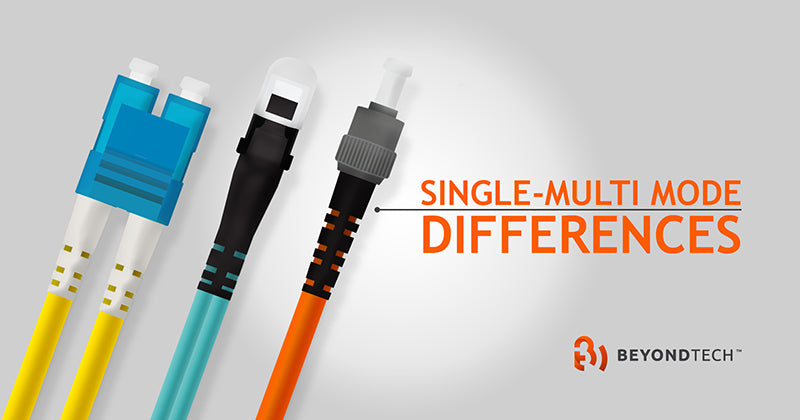Difference between singlemode and multimode fiber

Optic fiber bases its velocity on the speed at which these beams of light travel from one point to another. There are two types of fiber cables that are commonly used it, singlemode and multimode. Both have a conduit in the center called its core through which the light travels in a straight line or by bouncing off the walls made of cladding, an optical material that helps bounce the light.
Speed is the premise of optical fiber and it has revolutionized the market and changed the way that we connect because of it. Reaching up to 100 Gbps, data transmission is near instantaneous thanks to the beams of light that travel throughout the fiber.
Singlemode patch cords: It has the peculiarity that inside of its core, data travels without bouncing off of its walls which allows and maintains higher transfer speeds. The data transfers linearly which means that not too many beams of light can travel at once through the tiny proportions of this conduit. This type of fiber is used to cover great distances and it’s constructed with cores that can measure 9 microns with a cladding of 125 microns.
There are two types of singlemode cables:
OS1 Singlemode cable can be use in indoors situations, where the distance it can be deploy is maximum 2,000 meters. This allows up to 1 to 10 gibabit in Ethernet.
OS2 Singlemode are designed for all uses, making it more than suitable to outdoor purposes. The distance it can be deploy variate between 5,000 metres to 10,000 metres. This allows up to 1 to 10 gibabit in Ethernet. OS1 and OS2 are large distance cables due it the poor capacity to bend.
Singlemode is very useful to transmit data over long distances, thus making it perfect for college campus and cable television networks, singlemode fiber is a vital part for broadband networks
Multimode patch cords: This is the “domestic” fiber and in contrast with singlemode fiber, it allows the beams of light to bounce off of the cladding walls resulting in a greater quantity of light beams traveling at once through the core. In contrast with the singlemode, the multimode's core measures 50 to 62.5 microns, granting more space for data to travel through. The cladding of 125 microns grants the light to bounce and travel through the fiber. Multimode fiber is used for local-area network, build-to-build data centers and to be used it FTTH. Multimode also may reach up to 100Gbps Ethernet.
Ethernet variants over multimode fiber

Checking which cable is most suitable for your projects or needs is very important, and may even signify a better investment. When you are building your network backbone you need to be prepare for a variety of situations, considering factors such as attenuation. For any FTTx structure you will probably need singlemode and multimode, but the selections of the exact type will make the job a "plug-and-play" situation.








